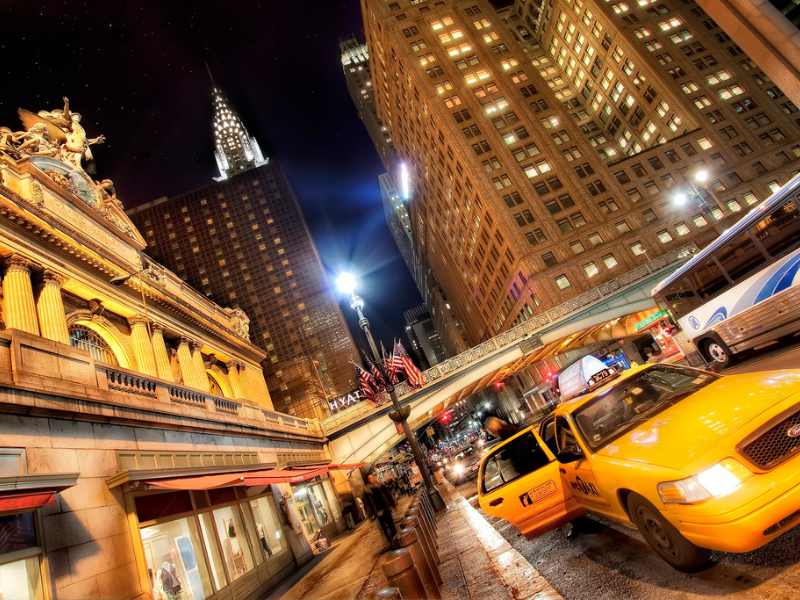
Moving NYC Forward: The Importance of a Transportation Renaissance

The Covid-19 pandemic exacerbated problems that have plagued New York’s transit system for decades. Use of public transportation in New York City is still about half of pre-pandemic levels, and, as more New Yorkers turn to personal vehicle use, the City just placed lowest in a ranking of the worst US cities for driving. Now is the time for an innovative transportation renaissance to ease the daily commutes of millions of New Yorkers, reduce emissions, and create a sustainable transportation future.
While transit experts, government officials and business leaders all agree that saving the Metropolitan Transportation Authority (MTA), the state agency that runs North America’s busiest subway, bus and commuter rail network, is critical to New York’s long-term economic success, we still lag behind cities like Hong Kong based on factors including distance to public transit, affordability, operating hours, crowding and commute speeds.
Innovative technologies, enforcement tools and policy solutions are emerging, and now is the time for New York State and New York City to deploy practical tactics to improve the accessibility of the transit system, encourage use of alternative modes of transportation, and improve the efficiency of curbside space.
It begins with providing long-term, sustainable funding sources for the MTA to ensure equitable service across subway, bus and rail lines. Transit advocates were successful in securing additional funding –and avoiding service cuts – for the agency in the recent state budget. This includes $1.1 billion in revenue that will be generated by an increase in the Payroll Mobility Tax and $300 million in one-time aid. The state budget also included $15 million for a free bus pilot program, which will result in one free bus route in each borough. While the MTA has not yet announced which routes will be included in the program, this two-year pilot will encourage greater use of the bus network – a critical lifeline in communities underserved by the subway system.
E-Micro-Mobility Solutions
New York City’s Department of Transportation (DOT) has already started exploring common sense solutions such as pilot programs for e-scooters and e-cargo bikes. Expansion of these pilot programs is key to transitioning New York into a 21st century transportation hub.
In 2020, the New York City Council passed legislation to authorize the use of e-scooters. Working with companies like Lime, NYC DOT developed a successful e-scooter pilot program in the North Bronx, a historic transit desert. Participation in the pilot has been encouraging, and New York City plans to expand on the program to Eastern Queens in 2024. Like the Citibike program, e-scooters have helped expand opportunities for residents, helping New Yorkers easily commute between home, work, or school.
As the availability and popularity of e-micromobility devices, likes e-bikes and e-scooters, continues to grow, the City also needs to continue to invest in the infrastructure to support their use. Mayor Adams and the Council have also taken steps to improve the safety of e-bikes and rechargeable lithium-ion batteries. In 2022, Mayor Adams launched an Interagency Task Force focused on preventing battery fires and released an Action Plan with the first set of initiatives designed to meet these goals. The Council also passed important legislation establishing safety standards for e-bikes sold within New York City, and providing educational resources to delivery workers and others about safe charging methods.
Last week, the Mayor announced that New York City is receiving a $25 million grant to install charging stations on NYC Housing Authority (NYCHA) campuses. Especially for delivery workers who rely on e-bikes daily, these public charging stations will be an important resource to provide safe, reliable charging capabilities. Continued investment in public charging stations, and incentivizing the development of private charging will be critical to building a citywide network to support the adoption of e-micromobility options.
Additionally, the City has the opportunity to change the way New Yorkers receive goods through expanding the existing e-cargo bike pilot program and other policy measures. Earlier this year, NYCDOT announced a microdistribution hub pilot program that will support cargo bikes and reduce the number of trucks on the road. The City could also implement policies such as “Green Zones,” which would establish dedicated curbside space for zero-emission commercial trucks. Combined, microdistribution hubs and Green Zones create a connected network for sustainable deliveries
Equitable Access
There’s also a need for equitable transit access. Millions of New Yorkers, especially those that live in eastern Queens, southeastern Brooklyn, and sections of the Bronx like Hunts Point, live in ‘transit deserts’, which refers to limited public transportation options and a lack of infrastructure. Staten Island is still the only borough that doesn’t connect to NYC’s subway system, and does not yet have access to the Citi Bike bike share program. Keeping these neighborhoods cut off from reliable transportation has an enormous economic impact on our city, often making it challenging for residents to access job opportunities, schools, medical care and other necessities. For example, people that live in Flatlands, Brooklyn, only have access to 75,000 jobs while residents of Midtown Manhattan have easy access to 3 million jobs. Expanding micromobility options and alternative transit services will help to alleviate these challenges.
Equitable access also means accessible transit access for those with disabilities. Following a lawsuit brought by advocates for people with disabilities, the MTA has vowed to make subways 95% accessible, but it will take decades and cost billions to add elevators and ramps to stations. The City’s Zoning for Accessibility text amendment, also known as the ‘Transit Density Bonus Program’, incentivizes developers to install elevators and related upgrades in nearby subway stations in exchange for more building density and has proven to be successful. Recently approved projects in Long Island City, Midtown, and other neighborhoods will add vital accessibility improvements in the coming years.
Building a Sustainable Transportation System
New York City has been a leader on climate and sustainability. Improving our transit system and adopting new technologies to reduce dependence on personal vehicles are critical steps to achieving bold and necessary environmental goals. While New York City is continuously making strides, continuing to invest in the existing transit system and new technologies will provide a multipronged approach to a sustainable transportation future.
Congestion Pricing
NYC officials are still working to implement a congestion pricing plan that would charge EZ Pass motorists between $9 to $23 to enter Manhattan south of 60th Street. The congestion pricing plan—first of its kind in the US—received federal approval on June 26 and will implemented sometime in 2024. The Transit Mobility Review Board (TMRB), the six-member panel that will issue a recommended tolling structure to the MTA, has been meeting over the summer, and in August debuted the first new toll scanning devices by Columbus Circle, the first tangible sign of the concept turning into a reality.
MTA officials expect congestion pricing to bring in $1 billion in new revenue a year that the agency will bond against to raise $15 billion. Those funds will help finance major capital projects like expanding the Second Avenue Subway to Harlem, updating the subway signal system and adding more elevators and escalators to stations to make them accessible.
In addition to congestion pricing, bike-share programs and opening up streets to pedestrians help cities ramp up usage of their public transit systems quickly
Best International Transit Systems
Globally, Asian and European cities rank highest for the best public transit systems, with Hong Kong ranked first based on factors including distance to public transit, affordability, operating hours, crowding and commute speeds, according to a new study from the Oliver Wyman Forum, a think tank affiliated with the consulting firm by the same name, and the University of California Berkeley’s Institute of Transportation Studies. Hong Kong’s mass transit railway was cited for its low fares, limited delays or service disruptions, and for supporting itself financially.
Bus Improvements
The NYC DOT is also working with the MTA and NYPD to improve bus service citywide. The Better Buses Action Plan is focused on improving bus speeds citywide by 25% and reversing downward bus ridership trends. This will be accomplished through installing new bike lanes, increased camera and NYPD enforcement of bus lanes, service management initiatives and bus network redesigns by MTA.
NYC Park Smart
Exploring options such as NYC PARK Smart is aimed at making parking more accessible and reducing congestion from “circling” for parking. PARK Smart increases the number of available parking spaces by encouraging motorists to park no longer than necessary. The meter rate is higher between noon and 4 pm when demand for parking is the greatest and decreases when demand is lower. Creating technology that helps free up curbside space, including enforcement technology, is critical for NYC.
_
The solutions detailed here are not a silver bullet, but rather a jumping-off point for further discussion and innovation. They can coalesce into a transit system that is efficient, streamlined, and optimized for New Yorkers (or “and usable to the most people”). Government must work with advocates, businesses, and other stakeholders to create common-sense solutions to catalyze a transit renaissance.



